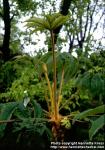Preparation: Tincture of Aralia Spinosa
Related entries: Aralia Hispida.—Dwarf Elder - Aralia Nudicaulis.—False Sarsaparilla - Aralia Racemosa.—Spikenard
The bark of the Aralia spinosa, Linné.
Nat. Ord.—Araliaceae.
COMMON NAMES: Prickly elder, Angelica tree, Hercules' club, Toothache bush or tree, Southern prickly ash (improperly so-called).
Botanical Source.—The Aralia spinosa is a small tree, with an unsymmetric, naked stem, about 10 or 12, sometimes 20, feet high, but taller in warm latitudes, having prickles below, and the leaves all crowded near the summit. The leaves are very large and long, often 3 to 6 feet in length, prickly, bipinnate, and borne on long, prickly petioles. The leaflets are ovate, acuminate, serrate, sessile, and glaucous beneath. The flowers are white, and disposed in numerous umbels, forming a very large panicle. The involucres are small and few-leaved. The fruit consists of blackish, juicy berries.
History.—The prickly elder inhabits the United States in various parts, from Pennsylvania to Louisiana, and westward to Missouri, growing in damp and rich woods and fields. The thin, ash-colored bark is the part used, although other parts of the plant possess medicinal properties; it has a peculiar, somewhat fragrant odor, and a slightly bitter, biting taste; alcohol or water extracts its properties. It is frequently grown in the Northern States for ornamentation. It blooms in August and September.
Description.—Aralia bark, as it occurs in drug houses, is curved, or in thin quilled pieces, with an external gray, smooth surface, or slightly marked with linear elevations, and the stem-bark usually with transverse lines of slender prickles, or in the absence of these, short ridges running crosswise. Beneath the corky layer, the color is brownish-green or green. The inner bark is composed of layers concentrically disposed, and breaks with a smooth, but tough fracture. The taste is sharp, acrid, and bitter; the odor slightly balsamic.
Chemical Composition.—The chemical investigations of this bark by different authors present somewhat conflicting results. L. H. Holden (Amer. Jour. Pharm., 1880) found in it fat, tannin, a slightly acrid resin, and a yellowish glucoside to which he gave the name araliïn. It is soluble in alcohol and water, and froths considerably in aqueous solution upon shaking. Araliïn, when acted upon in aqueous solution by hydrochloric acid, splits into sugar and a white, insoluble, tasteless body, called araliretin by Holden. Elkins (Amer. Jour. Pharm., 1880) demonstrated the presence of the following organic constituents: starch, glucose, pectin, gum, two acrid resins, a volatile oil, and an alkaloid. The latter constituent, however, J. K. Lilly failed to obtain (Amer. Jour. Pharm., 1882). Lilly isolated the volatile oil by distillation; also the bitter, amorphous, extract-like principle, the resinous, acrid principle, and obtained Holden's araliïn in pure form, characterized by its striking saponaceous property. Satisfactory tests for tannin were not obtained by Lilly.
Action, Medical Uses, and Dosage.—The fresh bark will produce vomiting and purging; but when dried it is a stimulating alterative, producing a determination toward the surface. The tincture has been used in syphilitic and rheumatic affections, and in some diseases of the skin. The warm infusion, especially when strong, is apt to induce vomiting. Ɣ The berries in tincture have been found useful in lulling the pain from a decayed tooth; also in various painful affections of other parts. Much use was made of this bark by physicians in Cincinnati during the cholera of 1849-50, in cases where cathartics were required, but where the action of every purgative was difficult to control; the preparation was composed of 1 drachm of compound powder of jalap, 1 drachm of aralia spinosa, and 2 drachms of compound powder of rhubarb. Given in powder, in half-teaspoonful doses; or the powder was infused in half a pint of boiling water, of which infusion, when cold, a tablespoonful was given every half hour. In no case in which it was given did it produce a tendency to looseness or choleraic discharges. It is a powerful sialagogue, and is valuable in diseases where the mouth and throat are dry and parched, as a very small portion of the powder will produce a moisture and relieve difficult breathing; also useful in sore throat. The dose of tincture (bark ℥viij to dilute alcohol Oj) is from 5 to 60 drops, of the infusion (℥ss to aqua Oj) a tablespoonful to a wineglassful.
Related Species.—Aralia edulis, Siebold. In Japan it is universally cultivated in fields and gardens, where it attains a height of 3 or 4 feet, flowering in August, and ripening its bluish-black berries in November. It is valued chiefly on account of its root, in Chinese trade called Tang-Kwei, which is eaten like scorzonera, but the young stalks are likewise a delicious vegetable. The root is fleshy, resembling gentian, and has a sweetish, aromatic taste, and an odor approaching that of celery or angelica. It is said to be brought from Western China (Hanbury, Science Papers).
 Aralia papyrifera, Hooker. (Properly Fatsia papyrifera, Decaisne and Planchon.) Native of Formosa. The so-called Rice paper tree of the Chinese. The pith of the stem (1 to 1 ½ inches in diameter) is unrolled by cutting with a sharp knife from circumference to the center. flattened and pressed in small sheets known as Rice Paper, and used in ornamental fancywork, especially to imitate delicate petals in making artificial flowers. For description and illustration see Am. Jour. Pharm., 1879, p. 241.
Aralia papyrifera, Hooker. (Properly Fatsia papyrifera, Decaisne and Planchon.) Native of Formosa. The so-called Rice paper tree of the Chinese. The pith of the stem (1 to 1 ½ inches in diameter) is unrolled by cutting with a sharp knife from circumference to the center. flattened and pressed in small sheets known as Rice Paper, and used in ornamental fancywork, especially to imitate delicate petals in making artificial flowers. For description and illustration see Am. Jour. Pharm., 1879, p. 241.

